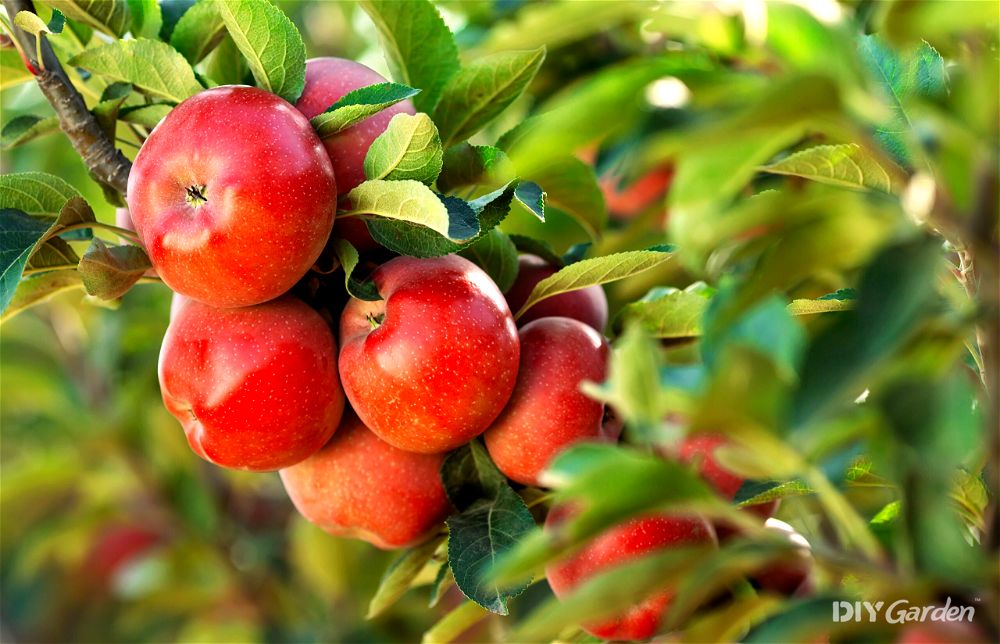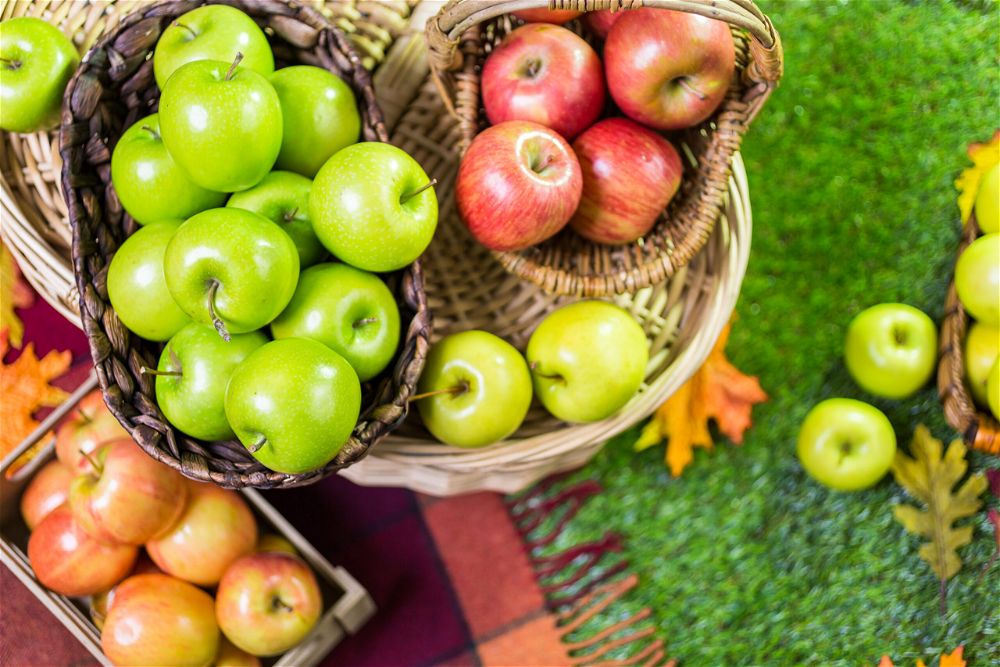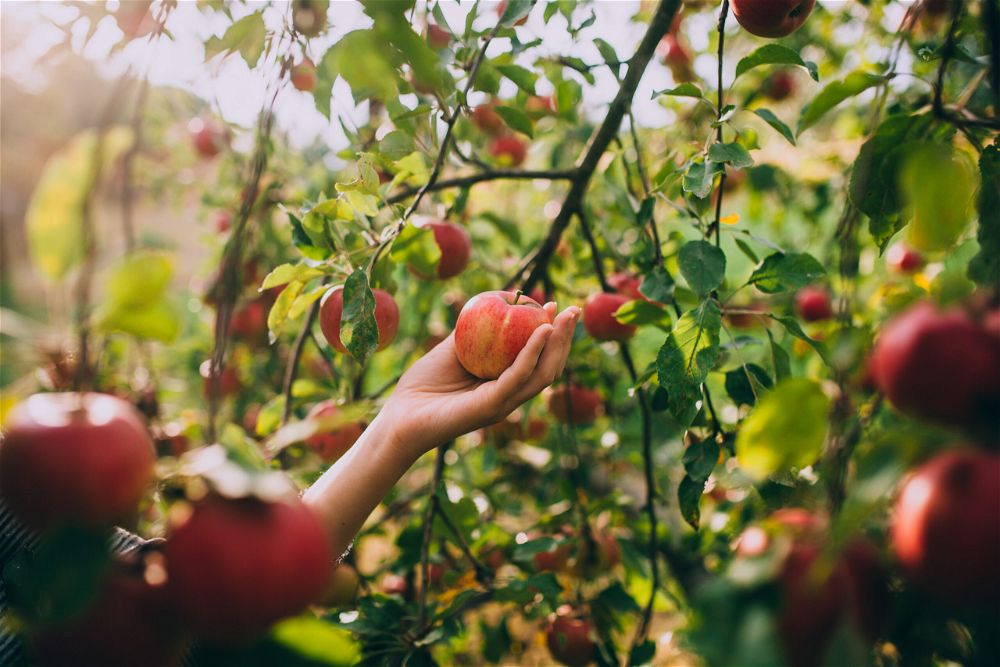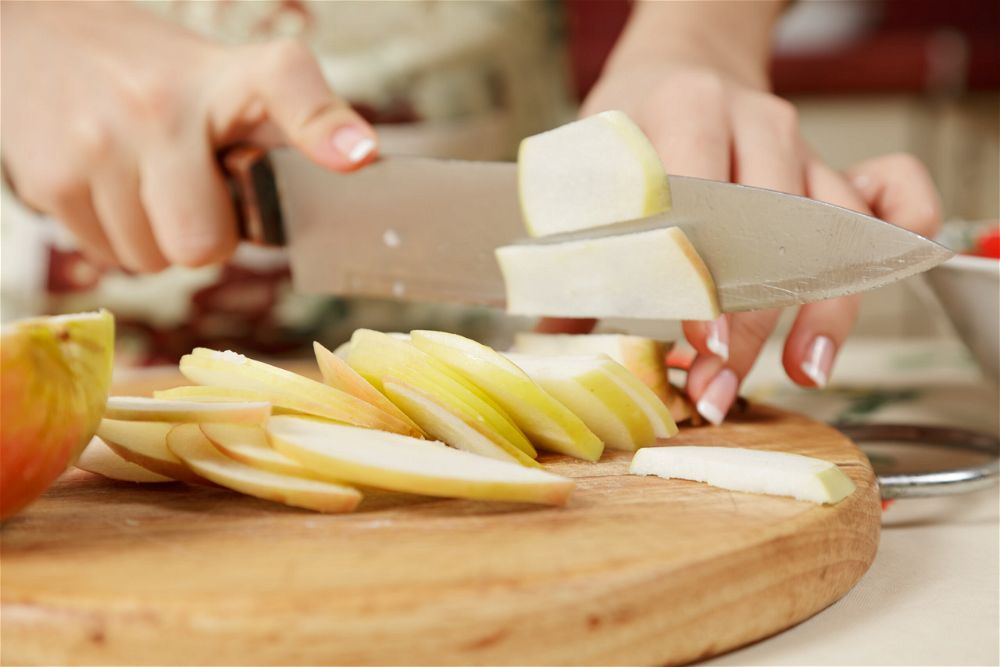
Not only does an apple tree make for a beautiful focal point in the garden, but when cared for in the right way, apple trees can be incredibly productive. They can provide enough fruit to feed both you and the wildlife around you for several months.
If you’ve been thinking about adding some of these low-maintenance trees to your garden, you’ve probably got a few questions. How long does it take to grow an apple tree? Is it worth doing planting from seed or is it better to plant an established tree? Read on – we have the answers!
Growing Apple Trees: A Quick Snapshot
When to Sow: Oct-Feb
When to Plant: Nov-Mar
When to Harvest: Aug-Oct
Average Yield per Plant: 200-800 apples
Spacing: 2-8m
Depth: 30-60cm
How Long Does it Take to Grow an Apple Tree?
How long it takes to grow an apple tree depends on the tree variety, whether you’re growing from seed, and how effectively the tree’s growing requirements are being met. Depending on the type of tree, it can take anywhere from two to ten years for apple trees to start bearing fruit.
In this section we’ll explain more about the growing conditions for an apple tree, as well as the different varieties, which will all affect how long it takes to grow and harvest your tree.
Growing Conditions for an Apple Tree
Although light requirements vary between varieties, apple trees generally require about 8 hours of sun a day during their growing season. An apple tree in the shade will take longer to grow and will also be quite spindly, meaning that there’s a higher chance of it bending and breaking once it starts to bear fruit.
Although sun is important during the spring and summer, apple trees don’t generally do well in temperatures higher than 32°C. They make up for this by being extremely cold hardy – some varieties can withstand a winter chill of -40°C!
It’s worth noting that, in order for pollination to take place, you need to have more than one apple tree. If your neighbours have an apple tree, or there are wild crab apple trees growing nearby, then this should suffice – so long as they’re within around 30 metres of your own tree. If not, then you’ll need to purchase two trees if you’re hoping for homegrown apples.
How much space will each tree need? This depends on whether you’re growing dwarf, semi-dwarf, or standard trees…
Dwarf vs Semi-Dwarf vs Standard Trees
If your garden is on the smaller side, or you’re growing your trees in pots, then a dwarf apple tree will be best – they usually grow to between 1.8-2.4m in height, and need roughly the same amount of space around them. Even better, they can often start to produce fruit just a couple of years after planting.
On the other hand, standard apple trees are much larger. They can grow up to 8m in height, and will therefore need that much space around them too. They also take a few more years to produce fruit – 4-6 is the norm. However, if you have the space, the wait is worth it, as standard apple trees tend to be the most productive.
Semi-dwarf trees sit somewhere in the middle of standard and dwarf varieties, both in terms of size as well as the amount of time they take to produce fruit.
As you can see, there are already several factors contributing to how long it takes to grow an apple tree. However, there’s something else that you need to consider too; growing from seed vs planting a grafted rootstock.
Growing an Apple Tree From Seed
It can take a while to see any fruit from an apple tree grown from seed – you could be waiting for between 5-10 years. What makes this even more of a risk is that apple seeds very rarely run true to type. This means that even if you’ve saved the seeds from a super sweet apple that you recently enjoyed, there’s no guarantee that the apple tree you grow would produce the same variety of apple (and it’ll take you 5-10 years to find this out!).
That said, there’s definitely a strong sense of satisfaction that comes from growing apple trees from seed. Plus, you never know, you could end up with fruit that’s even tastier than the apple you saved seeds from. So, if you’d like to give this a try, follow these steps:
- Gather as many seeds as you can. The germination rate for apple seeds is only about 30%, so you’ll need to have plenty spare.
- Place your seeds into a plastic bag with a damp paper towel, leaving the bag open a crack. Put this into your fridge for at least 6 weeks, ensuring that the towel stays moist.
- After 6 weeks, you’ll notice that some of your seeds have sprouted. Move these into small pots, planting them so that the sprouted part is just above the surface of the soil.
- While you could also plant them outside at this stage, survival rates are higher if you keep your seedlings in pots until they’re about 15cm tall.
Growing an Apple Tree From a Grafted Rootstock
If you decide to purchase an apple tree rather than growing one from seed, then chances are that it will be a grafted tree. This is a good thing – it means that the rootstock will have been specifically chosen for size, disease resistance, and more. It’s also usually easier to prune, thin out, and harvest grafted trees in comparison to those grown from seed.
The rootstock that the tree has been grafted onto will also hugely influence how long it takes for your apple tree to grow. If you’re hoping for apples in the next two years, choose a rootstock that’s known for its high productivity.
How to Plant an Apple Tree Outside
Once you’ve chosen a sunny spot to place your tree in, use a spade to dig a hole that’s the same depth as your tree’s root ball, but double the width. If you’re planting a bare root tree in a windy location, it would be advisable to hammer a stake in at this stage.
Then, plant your tree. If your tree was grown from seed, plant it at the same depth that it was in when it was in a pot. If it’s a grafted tree, plant it so that the grafted point is about 10cm above the ground.
Spread the roots out as you place your tree into the hole. Then, hold it steady and straight with one hand while backfilling the hole with the other. Firm the soil down, water well, and then add more soil if necessary.
How to Care for an Apple Tree
Although apple trees are generally quite low maintenance, giving your tree the best care possible will ensure bigger harvests:
Watering Your Apple Tree
Mature apple trees aren’t too fussy when it comes to water, but newly planted trees will need to be kept well watered during their growing season in order to keep them healthy. Aim for about 2-3cm of water per week from April until October.
That said, be careful not to over-water your apple trees as this will cause them to rot.
Feeding Your Apple Tree
Apple trees don’t need to be fed much, especially if they’re in good soil. Applying a fresh layer of compost around your tree once a year will usually be enough to take care of the tree’s nutrient requirements.
While it may be tempting to give your apple trees some feed while you’re fertilising the other plants in your garden – don’t. This will encourage lush leafy growth, which will prevent fruit development while also leaving the tree susceptible to certain diseases.
Pruning Your Apple Tree
The best time to prune an apple tree is at the end of the winter – once the coldest weather is done but before new growth begins in the spring.
Ideally, you want your apple tree to take on a conical/pyramid form. The branches should be well balanced and spaced out, and limbs should never be crossing over each other.
Diseased or damaged branches should be removed as well, as should any suckers that grow from the base or the trunk.
Try to keep pruning to a minimum with young trees, as this can hinder fruiting.
Weeding & Mulching Your Apple Tree
Weeds and grass will steal moisture from the soil around your apple tree, which will interfere with its growth. Try to keep a 1m radius around your tree weed-free.
One good way to suppress weeds would be to apply a mulch around your tree. Go with an organic mulch, as this will enrich the soil as it breaks down.
Popular Apple Tree Varieties to Grow
There are more than 7500 varieties of apples grown around the world. However, some of the most popular among home gardeners are:
- Spartan – crisp red skin with juicy white flesh makes this stunning apple a strong favorite
- Bramley – a variety that’s grown almost exclusively in the UK, the Bramley is one of the most popular cooking apple varieties available
- Chivers Delight – a firm and nutty apple that’s quite acidic, which helps it to store well
- Greensleaves – a yellow variety that’s light, crispy, and full of flavour
- Howgate Wonder – an all-rounder variety that produces very large apples
Common Apple Tree Problems
There are a variety of different pests and diseases that could potentially affect your apples. If you notice a problem occurring, try to treat it straight away. That said, even if you’re late in treating your tree, chances are that you’ll still get some sort of harvest – apple trees are productive enough that there should still be plenty of fruit for you to pick, even after the birds and bugs have had their share.
Here are some of the most common apple tree problems that you may encounter:
- Apple scab – you’ll notice brown circular patches on the leaves of your tree in the spring, with this soon distorting any fruit that grows. Organic fungicides can help, as can covering each fruit with a bag. Make sure that you rake away infected leaves every autumn, and perhaps consider investing in a scab-resistant variety if this issue has spread to multiple apple trees in your garden
- Aphids – this pest causes the young shoots and leaves of an apple tree to curl and turn sticky. Smothering the aphids in an insecticidal soap is a good way to clear an infestation
- Apple sawfly – if you notice apples falling from your tree in June/July, with the flesh looking eaten, then the apple sawfly could be responsible. A strong jet of water will wash them off, and you should also remove any affected fruits. Clearing away any weeds or shrubs from around your apple tree in the spring will help to remove any pests that have been overwintering nearby
How to Harvest Apples
The best way to tell if your apples are ripe and ready for picking is by tasting one. Unripe apples will be very starchy and will feel quite sticky in your mouth. However, since apples won’t all ripen at the same time, you’ll need to do the taste test with a few different apples on your tree. This also means that your tree will likely need more than one harvest, although unripe apples still work well in cooked dishes.
To harvest your apples, gently cup a fruit in your hand. Lift it up slightly and give it a twist – it should come away from the stem easily. Be gentle so that you don’t bruise the fruit.
How to Store Apples
Apples store well in a fridge, but if you’re hoping to store enough apples to last you until your next harvest, you can also keep them in a cool, dark, and frost-free area. To prolong shelf life, each apple should be individually wrapped in paper or tissue, and then placed into a box. The more you’re able to prevent them from touching each other, the longer they’ll last.
That said, you should still be looking through the box every week or so. Remove any apples that are starting to rot, otherwise that one bad apple could affect the entire box.
How to Prepare & Cook Apples
Apples can be eaten as they are, which doesn’t require any prep work. However, if you have a huge glut of apples, then, in addition to storing some over the winter, you could try cooking and preserving some too. Here are a few delicious ideas to try:
- Apple jelly
- Apple butter
- Apple chutney
- Apple crumble
- Apple sauce
- Dried apples
- Apple juice/apple cider
Conclusion
With its majestic blossom in the spring followed by gleaming fruits that continue to swell through the summer, a humble apple tree provides so much garden interest during the warmer months. Go with an apple tree grafted onto a productive rootstock and you could be picking fresh, homegrown apples in just a couple of years, with your harvests getting bigger and better as each subsequent year progresses. If you choose to grow from seed, it could take around five to ten years to see fruit, and you’ll have no guarantee of the variety, but it’ll be an interesting and rewarding experience.
FAQ
Can you grow an apple tree from store-bought apples?
Yes, you can plant the seeds of a store-bought apple to grow a new apple tree. However, you’re unlikely to end up with the same variety of apple that you started with. It could be better or it could be worse – it’s almost like playing the lottery!
How long do apple trees live?
Apple trees usually live for about 50-80 years. That said, there are some apple trees around the world that are over 100 years old! An apple tree’s lifespan will depend heavily on its variety, as well as the growing conditions that it deals with.
Can you grow apple trees in pots?
Apple trees grow well in pots, so long as you choose a variety that’s suited to restricted space. Dwarf apple trees tend to be the best ones to go for if you plan on keeping them in a container.







